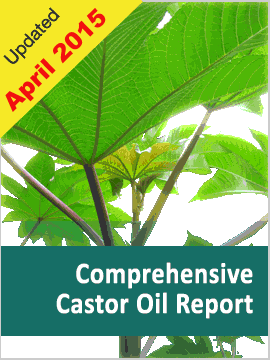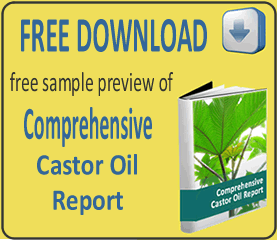Castor Oil & Derivatives Uses & Applications Info @ CastorOil.in
CastorOil.in provides you links & resources related to castor, castor oil, castor derivatives & castor oil producers. We hope to make this a one-stop resource for all info about castor and castor products, and hope that you find this site to be of use.
This section of CastorOil.in focuses on the uses and applications of castor oil & its derivatives.
Note:
- If you are looking for Indian companies to source castor oil or castor oil derivative products, please see Castor Sourcing Directory.
- If you looking for inputs on other plant oils, please see Plant Oils WWW Resources ( Plant Oils A-Z )
- If you are looking for castor industry terms & definitions, see Castor Dictionary & Castor Oil Translations
A Comprehensive
Report on Castor Oil from
CastorOil.in manufacturers, derivatives,
castor oil chemicals end-uses, castor meal / cake, prices, manufacturing,
cultivation, specifications see here all you wish to know
about the world of castor, all in one report
The following are the sections in this page:
- Castor Oil & Castor Derivatives Sourcing
- Castor Crop Resources
- Castor Oil Extraction
- Castor Oil & Derivatives
- Uses of Castor Oil & Castor Derivatives
- Castor Oil & Derivatives Trade & Industry
- Castor Oil Research
Uses of Castor Oil
The uses of castor oil have changed over the years. Many years ago, castor oil was primarily used for medicinal purposes and as a general industrial lubricant. Later, chemical engineers were able to produce derivatives of the oil that found many more uses. Sulfonated (sulfated) castor oil, or Turkey Red Oil (Sulfonation from Encyclopedia Britannica), was the first synthetic detergent (Development of the Detergent Industry from Chemistry New Zealand) after ordinary soap, and other forms of the oil became important for the treatment of leather, industrial lubricants, and other industrial uses. Today, chemical engineers have come up with many uses of castor oil and its derivatives such as: Polyamide 11 (Nylon 11) engineering plastic (Polyamide 11, Nylon 11 Info from Indian Plastic Portal), lubricating grease, coatings, inks, sealant, aircraft lubricants, surfactants (Surfactants Info from Chemistry New Zealand, Surfactants the Ubiquitous Amphiphiles The Royal Society of Chemistry), emulsifiers (Emulsifiers Info from Paisley College), encapsulants, plastic films, plasticizer for coatings, and components for shatterproof safety glass. Castor oil has even made its way into cosmetics and related products due to its non comedogenicity (Comedogenicity from Derma Doctor). Thus, castor oil and its derivatives have become an important commodity to the chemical industry.
The chemical structure of castor oil affords a wide range of reactions to the oleochemical industry (Oleochemical Directory from Open Directory, Oleochemicals from Wikipedia) and the unique chemicals that can be derived from it. These derivatives are on par with petrochemical products (Overview of the Petrochemical Industry from the Virtual Chembook, Petrochemical Info from Wikipedia) for use in several industrial applications. In fact, they are considerably superior since they are from renewable sources, bio-degradable (Bio-degradable Info from Worldwise) and eco-friendly.
Castor Oil is regarded as one of the most valuable laxatives (Laxative Definition & Info from Web MD) in medicine. Castor Oil forms a clean, light-colored soap, which dries and hardens well and is free from smell. Externally, the oil has been recommended for various cutaneous complaints. Castor Oil is an excellent solvent of pure alkaloids (Alkaloids Info from Virginia Commonwealth University) and such solutions of Atropine (Atropine Info from Oxford University, Atropine from Wikipedia), Cocaine (Cocaine Resources from MedLinePlus, Cocaine from Wikipedia), etc., as are used in ophthalmic surgery. It is also dropped into the eye to remove the after-irritation caused by the removal of foreign bodies.
Castor Oil is finding increasing uses in the industrial world. Castor oil has been used in skin care products for centuries, and it continues to play an important part in the production of soaps and cosmetics. It figures largely in the manufacture of the artificial leather used in upholstery; it furnishes a coloring for butter, and from it is produced the so-called Turkey-Red Oil (Turkey Red Oil Info from Porwal Chemicals) used in the dyeing of cotton textures. It is an essential component in some artificial rubbers, in various descriptions of celluloid (Celluloid from Wikipedia), and in the making of certain waterproof preparations, and one of the largest uses is in the manufacture of transparent soaps (A Closer Look at Glycerine Soaps from Ecomall). It also furnishes sebacic acid which is employed in the manufacture of candles, and caprylic acid (Caprylic Acid / Octanoic Acid from Wikipedia), which enters into the composition of varnishes. Castor oil is also a source of glycerine, and the combination of glycerine and hydroxy fatty acids makes it an excellent emollient and pigment carrier.
Even its stem finds use, since the stems are made into paper and wallboard.
Considered anodyne, antidote, aperient, bactericide, cathartic, cyanogenetic, discutient, emetic, emollient, expectorant, insecticide, lactagogue, larvicidal, laxative, poison, purgative, tonic, and vermifuge, castor or castoroil has been an ingredient in folk remedies for abscess, anasarca, arthritis, asthma, boils, burns, cancer, carbuncles, catarrh, chancre, cholera, cold, colic, convulsions, corns, craw-craw, deafness, delirium, dermatitis, dogbite, dropsy, epilepsy, erysipelas, fever, flu, gout, guineaworm, headache, inflammation, moles, myalgia, nerves, osteomyelitis, palsy, parturition, prolapse, puerperium, rash, rheumatism, scald, scrofula, seborrhea, skin, sores, stomachache, strabismus, swellings, toothaches, tuberculosis, tumors, urethritis, uteritis, venereal disease, warts, whitlows, and wounds! The oil and seed have been used as folk remedies for: warts, cold tumors, indurations of the abdominal organs, whitlows, lacteal tumors, indurations of the mammary gland, corns, and moles, etc. Castor-oil is a cathartic and has labor-inducing properties.
More: Castor Oil Uses from Annie Appleseed Projects New
Castor Oil & Castor Oil Derivatives Uses - Summary
Details of area of use & the castor products used in that area.
- Agriculture
End Products
- Fertilisers Organic Fertilizers (Organic Fertilizers Info from Virginia State University, Making a Complete Organic Fertilizer West Side Gardener)
- Hybrid Castor Seeds (Hybrid Seed Info from Wikipedia)
- Food
- End Products
· The Seed Contains 35 - 55% of Edible Oil, Which is Used in Cooking
· Food Containers
· Surfactants
· Viscosity Reducing Additive
· Castor Oil Esters (An Introduction to Esters from Chem Guide)
- Textile Chemicals
- End Products
- Textiles and Textile Finishing Materials
- Dyeing Aids
- Nylon & Synthetic Fibers & Resins
- Synthetic Detergents
- Surfactants
- Pigment Wetting Agents
- Paper
- End Products
- Flypapers (Flypaper Definition & More from Answers.com)
- Defoamer
- Water Proofing Additive
- Plastics & Rubber
- End Products
· Polyamide 11 (Nylon 11)
· Plastic Films
· Adhesives
· Synthetic Resins
· Plasticisers, Plasticizers (Biochemical Plasticizers Info from Carbohydrate Economy, Plasticizer Info from Answers.com)
· Coupling Agents (Why Use Silanes as Coupling Agents from Special Chem 4 Polymers)
· Polyols (What are Polyols? From SPI Polyols)
- Perfumeries
- End Products
· Perfumery Products
· Heptaldehyde
· Heptanoic Acid
· Undecylenic Acid
· Heptyl Alcohol
· Ethyl Heptoate
· Heptyl Acetate
- Cosmetics
- End Products
· Lipsticks
· Hair Tonics
· Shampoos
· Polishes
· Castor Oil
· Emulsifiers
· Castor Oil Esters
· Undecylenic acid
· Deodorants
· Castor Wax
- Electronics & Telecommunications
- End Products
· Polymers for Electronics and Telecommunications
· Polyurethanes (About Polyurethanes from The Alliance for the Polyurethane Industry)
· Insulation
- Castor Products & Derivatives Used
· Castor Oil
· Castor Oil Esters
· Polyols
- Pharmaceuticals
- End Products
· Anthelmintic (Anthelmintic Info from Wikipedia)
· Antidandruff
· Antitussive (Antitussive Drugs Info from Vent World)
· Cathartic
· Emollient
· Emulsifiers
· Encapsulants
· Expectorant
· Laxatives & Purgative
· Castor Products & Derivatives Used
· Glycerine
· Castor Oil
· Undecylenic acid
· Zinc Undecylenate
· Enanthic Anhydride
· Calcium Undecylenate
· Hydrogenated Castor Oil
- Paints, Inks & Additives
- End Products
· Inks
· Plasticizer for Coatings (Brief Castor Oil Uses Info from JRC, Italy)
· Varnishes (Oil Slicks from Arbor Tech, Australia)
· Lacquers
· Paint Strippers
· Adhesive Removers
· Wetting & Dispersing Additives
· Castor Products & Derivatives Used
· Polyols
· Glycerine
· Dimer Acid
· Polyamides
· Alkyd Resins
· Ricinoleic Acid
· Thixotropic Agents (Thixotropic Agents Definition from Cherbsloeh)
· Castor Oil - All Grades
· Dehydrated Castor Oil (DCO)
- Lubricant
- End Products
· Lubricating Grease
· Aircraft Lubricants
· In Jet Engine Lubricants
· In Racing Car Lubricants
· Hydraulic Fluids (Hydraulic Fluids from Wikipedia)
· Heavy Duty Automotive Greases
· Fuel Additives
· Corrosion Inhibitors
· Castor Products & Derivatives Used
· Dimer Acid
· Ricinoleic Acid
· Castor Oil Esters
· Blown Castor Oil
· Heptanoic Acid
· Hydrogenated Castor Oil
· Hydroxy Amide Waxes
· 12 Hydroxy Stearic Acid
· Sebacic Acid
- Other Products
· Sealant
· Components for shatterproof safety glass
· Purgative (Purgative Definition from NDIF) Extracted from Castor Seed Used in Paints and Varnishes, and in Medicine
· Drying Oils
· Fungistatic (fungus-growth-inhibiting) Compounds
· Embalming Fluid
· Soaps
· Metallic Salts
- Bio-fuels (See also: Castor Oil as a Fuel @ CastorOil.in)
- Castor oil, owing to its chemical structure can be used as a bio-fuel in place of petrol-based fuels.
- Biotransformation of vegetable oils through the use of enzymes as catalysts has been a matter of intense investigation nowadays. Among several raw materials available, castor oil, obtained from the growing native castor plant, is one of the most versatile products with applications in food, pharmaceutical and cosmetic industries. Furthermore, the possibility of using biodiesel as an additive to mineral diesel, to result in a sulfur-free, with a higher-cetane number fuel from a renewable resource has motivated the biomodification of vegetable oils towards the reduction of environmental investments and import needs.
- Another advantage of bio-diesel is that it has in-built oxygen, which burns down the fuel completely and does not pollute the environment. GOCL has the unique distinction of being the first Indian company to set up a continuous cracking plant of castor methyl esters to produce Undecylenic Acid and Heptaldehyde.
- Related Links
- Greener Pastures for Bio-tech Co-ops? Department of Agriculture, Govt of USA
- Energy in a Castor Bean from Tierra America
- Optimization of Bio-diesel Production from Castor Oil Department of Energy, US- MS Word Document
- National (US) Bio-diesel Board
- Castor Oil as Bio-fuel from Mississippi State University
- Fuel of the Future from Redford University
- Bio-Diesel Info from Wikipedia
- More Info
- Castor Oil Uses and Castor Oil Packs
- Castor Oil Uses Info from Botanical Online
- Castor Oil Anecdotal Case Reports
- Castor Oil to Encourage Labour from Stork Net
- Castor Oil for Starting Labor from Gentle Birth
- Castor Oil Profile from Meridian Institute
- Non-edible Uses & Applications of Castor Oil from Welch Holme Clark

